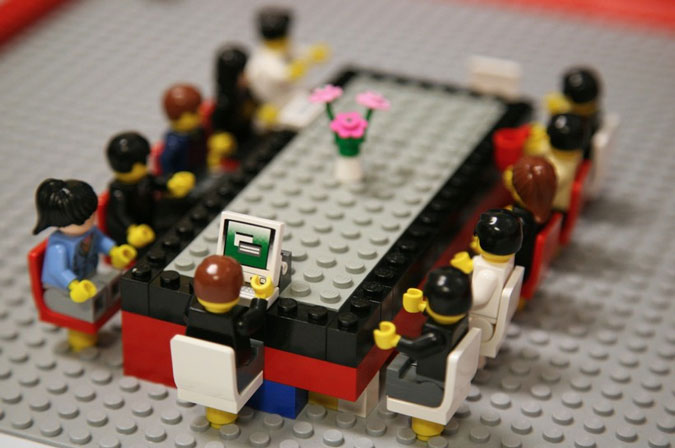Scope creep is a project manager's nightmare, which makes it an important part of our Introduction to Project Management course. In this post, our PRINCE2 and project management trainer Claudine gives a brief oversight of scope creep and how to manage it.

Firstly let’s clarify what scope is. It is the boundaries of what will be included or excluded from your project. For example:
- Features or functionality of a product
- Information or data included or excluded
- Organisations or stakeholders
- Procedures or processes
Managing scope creep is easier when using an established project management methodology like PRINCE2, which goes some way to explain why PRINCE2 Practitioner training is one of our most popular courses!
Why is it important to define scope?
One of the biggest gripes project managers have is of the “moving goal posts” or scope creep. This involves a large number of additions or changes to the requirements of a project, resulting in timescales and budgets to be exceeded. In addition, it also becomes difficult to plan and resource a project that is in a constant state of flux and transformation.
So it is important that scope is managed correctly so that the project manager is able to deliver a product within their objectives of time, cost, quality, scope, risk and benefit.
by Claudine
6 Nov 2012
‘Health and safety gone mad’; that well-worn phrase that's nearly as high up on the Daily Mail’s list of go-to headlines as ‘x gives you cancer’. People love to point to supposed incidents of over the top safety regulations as evidence of a growing nanny state culture in Britain.
In reality, these stories that make the headlines tend to be exaggerated at best and are just plain made-up at worst.

Even these guys have to wear hard-hats sometimes
Whilst some might seem quite funny, it is a serious issue that has badly damaged the reputation of Health and Safety as a concept. People believe these myths to be fact and then begin to view Health and Safety as over the top. This leads to people ignoring health and safety regulations on the whole, which results in an increase in serious injuries and deaths that could have otherwise been prevented.
As such the HSE is committed to disproving these wild claims in order to maintain the necessary regard for Health and Safety overall. Each month they choose a different myth and set out to prove that it has no actual basis in fact.
In that vein, we thought we'd come up with 5 of our favourites that the HSE has managed to disprove.
Need to learn or brush up on your Health and Safety regulations? Our Health and Safety courses are accredited by IOSH, the world's biggest health and safety membership organisation.
Andy Trainer
9 Nov 2012
Applying PRINCE2® to smaller projects can be difficult because it was originally designed to cope with the larger, more encompassing side of Project Management.
As such, when undertaking smaller projects, some Project Managers have a tendency to disregard PRINCE2 principles and take a more holistic approach. More often than not, this will be of detriment to the overall success of the project, as regardless of size it is still important to adhere to accepted processes within Project Management.
On our PRINCE2 training courses, our trainers go out of their way to make sure that everyone learns how to tailor PRINCE2 to their own project environment.

The 2009 'refresh' of PRINCE2 sought to give scope for the tailoring of PRINCE2 processes to projects of various sizes. As such, in this post we will discuss how to adapt key aspects of PRINCE2 to apply to small-scale projects and why this is so important. But first we'll discuss the way in which you shouldn't be managing small-projects.
Andy Trainer
13 Nov 2012
Ensuring quality is upheld with PRINCE2® is an ongoing process which means it requires continuous auditing. You can learn how to do this on our PRINCE2 Training Courses.
When managing a project with PRINCE2, it is necessary to prove to the customer that along the way, all the necessary quality management was undertaken. As such it is important to follow the Quality Trail.
In this post we'll outline each step of the Quality Trail, the resultant product and how to go about enacting it.

1/ Ascertaining Customer Expectations
Product = Project Mandate/Brief
Process = Starting up a Project (SU)
What needs to be done to make the end product adequate for customers and staff?
Andy Trainer
26 Nov 2012
APMG, the accrediting board for PRINCE2® have announced a format change to both the PRINCE2 Practitioner and Practitioner Re-Registration exams.
These changes have come about as result of a candidate survey which highlighted some issues with the timings of each exam. If you would like to learn all you need to pass your PRINCE2 exams, try our PRINCE2 Training Courses.
The fully changed formats for each are as follows:
Practitioner Exam
- 8 questions
- 10 question items per question, each worth one mark, total 80 marks
- 2.5 hours (150 minutes) duration, no additional reading time
- 44+ marks to pass (55%)
- Open book exam (official PRINCE2 manual only)
- Trainer pass mark - 53 out of 80 (66%)
Practitioner Re-Registration Exam
- 3 questions
- 10 question items per question, each worth one mark, total 30 marks
- 1 hour (60 minute) duration, no additional reading time
- 17+ marks to pass (55%)
- Open book exam (official PRINCE2 manual only)
- Trainer pass mark - 20 out of 30 (66%)
These changes will take immediate effect from January 1st 2013 and will entirely replace the 'old' format of the exams.
Andy Trainer
5 Dec 2012
The Plans theme is fundamental to the PRINCE2® methodology - the other themes (business case, organisation, quality, risk, change and progress) all depend on effective planning before, during and even after each project. A good plan will facilitate communication and control throughout the whole project life cycle.
Effective and structured planning also ensures that everyone involved in the project has the same information to work from and refer to. Crucially, in PRINCE2, all plans are created on a product-based technique – the final objective is identified first and then the plan is made of how to deliver this product.
Our PRINCE2 courses cover all of the PRINCE2 themes in detail, with a focus on real-life application of this knowledge.
The Planning Horizon
PRINCE2 can be applied to all scales of project, but detailed planning can be difficult for lengthier projects. If this is the case, the project will be broken down into smaller stages, and each of these will have separate plans. The planning horizon is the agreed length of time for which it is appropriate – or possible – to plan in detail.
Contents of PRINCE2 Plans
The different types of plans in a PRINCE2 project will follow a similar structure, in order to be easily accessible to everyone involved in the project. The level of detail that goes into each level of plan is determined by the scale of the project.
Andy Trainer
20 Jun 2012
Almost every person responsible for Health and Safety in the workplace has, at some point, had to consider how important the need for PAT testing is. Many people claim it’s a legal requirement – but is that a fact or a myth?
As we know that Health and Safety is so important to employers – yet surrounded by so much confusion - we offer a 4-day comprehensive Health and Safety course which is accredited by IOSH (the Institution of Occupational Safety and Health). Of course, protecting your employees from harm is your number one priority – but there are lots of other benefits of Health and Safety training as well.

Here are words from our trainer, Andrea, on the subject of PAT testing - and other Health and Safety myths.
Andy Trainer
21 May 2012
FAQ: Is training tax deductible?
At Silicon Beach Training we're commonly asked whether training is taxable 
or vatable so thought we would explain the general UK tax rules for both self-employed and employers here. Many business owners and HR managers presume that any costs incurred on training are tax deductible, however there are some exceptions depending on who is paying and what the purpose of the training is.
Once you've cleared up your tax confusions, have a browse of our many IT, Business and Management training courses: we offer SEO Training, Photoshop Training, PRINCE2® Training, HR Training and Train the Trainer Training.
Andy Trainer
8 Jun 2010